Keywords
student nurses, nurse teachers, older adults, attitudes, care
Introduction
Nursing care of older people becomes an emerging field nowadays. Population of older people is increasing in industrialized countries, and older patients are increasing in number as well [1,2,3]. The last decades the changes in demographic trends in Greece with an increasing in number of ageing people, particularly of people aged >65,4 indicate that student nurses must be adequately prepared in caring for older adults effectively. Effective practice utilizes different sources of knowledge, including intuitive knowledge, and is based on both clinical and theoretical experience. A holistic knowledge of the ageing process is required and the specialty of nursing of older people is rising as caring for the older people demands specific knowledge and abilities [3,4,5]. Current demographic and health utilization trends strongly indicate a rapidly increasing demand for nurses who are well qualified to care for older adults.
Edwards and Forster suggest that, where working with older people is concerned there is a lack in educational training for registered nurses as well as for all other groups of nurses and this may enforce the message that this specialty caring for older people does not require especially skilled nurses [6]. Not only is there a lack of education, but also inadequate education about normal ageing processes may influence negative attitudes [7].
The nursing science worldwide, in order to meet the demographic changes and the needs of older people, incorporated modules in the nursing curricula relevant with the ageing process and the caring of older adults. The module ‘’Gerontologic Nursing’’ is teaching in undergraduate and postgraduate Nursing studies, focusing in an integrated preparation of Nurses for a more effective management of the complex problems of the ageing process [8,9]. Although, advanced practice nurses are positioned to assume leadership roles in nursing care of older people, they must first obtain special introductory education. Gerontological nursing should not be used as a vehicle for teaching basic care such as hygiene, as this may influence nursing students to view the specialty as basic [10]. It is necessary for nurse educators to focus on their students views of the of older adults, as attitudes –conceptualized as feelings, knowledge and beliefs- are considered to be an important factor that influences both care and specialty selection [11]. Studies have demonstrated that the majority of students and registered nurses have neutral or slightly positive attitudes towards the older people and there are enough misconceptions about their capabilities. Over the last twenty years and despite the progress in nursing care, little has changed in the attitudes towards the older adults [11-13]. Cultural influences; age gender and education could have an effect on the attitudes towards older patients, positive or negative. In general, it is found that there is a lack of knowledge about the older people [11,14] even though senior students and teachers score better in the various questionnaires. A generally negative attitude is rather the rule. It is noted, however that females show more positive attitudes than males. Negative attitudes could result in neglect or abuse of older people [15]. The use of unnecessary physical restraints and little consideration of their ageing-related needs in emergency departments are some examples [15,16]. Wells et al. suggests that if nursing curriculums content is based on the teaching of health problems in old age, then this is more liable to enhance as opposed to work against negative stereotypes of older people. In Greece there already have been relevant changes in undergraduate curricula, but so far there is no reported evaluation of them in order to be discovered if they are appropriate for meeting the needs of ageing people. Consequently, nurse teachers have to examine both the quantity and the quality of modules of any nursing programmes [7].
The aim of this study was to investigate how teachers and student nurses in a Greek Nursing School Department view hospitalized older adults. The influence of gender, age and duration of academic studies was also considered.
Method
This was a cross-sectional study conducted in the Nursing Department, at the Technological Educational Institute of Lamia, in a provincial town, in central Greece. Following a review of the relevant literature, we chose a tool developed by Mclafferty [17]. The instrument appeared to be suitable for the present study and it includes 20 questions in the Likert five-point format type, ranged from ‘’strongly agree’’ to ‘’strongly disagree’’. Once we obtained the permission to use it, the scale was translated into Greek and back translated by another bilingual expert in order to ensure the accuracy of translation, after which it was tested on a group of 10 third-year student nurses near the end of their training and five teachers in order to ensure that the questionnaire was understandable and easy to complete. The returned questionnaires were fully completed and the response choices were adequate and understandable. Thus, no problems were recognized with face validity. The rationale for using a new scale was that some of the questionnaires which have been used in previous studies to measure attitudes are generic and may be used to measure society’s attitudes [17]. Another questionnaire including sociodemographic characteristics, such as, age, semester, marital status, educational level and employment status for the teachers of the study has been used. The protocol of the study was approved by the Institutional Ethics Review Board of the Technological Educational Institute of Lamia, Greece.
Potential subjects were recruited on the basis of their availability after an informed consent was obtained. They received a brief explanation of the purpose and the aim of the study by a member of the research team who had no dependent relationship with them, and those who agreed to participate were asked to sign an informed consent form. Participants were also assured that the collected data would be used only for the purposes of the study, and that their decision to withdraw or refusing to participate would not influence any teacher–student relationship, since all questionnaires preserved their anonymity. Data collection lasted from May to July 2008.
Consequently, the questionnaire was administered to 252 nursing students and 80 teachers from the Technological Educational Institute of Lamia and from one Technological Educational Institute in North Greece. Data from 76 nursing teachers (95% out of 80 questionnaires were returned) and 245 students (97.2 % out of 252 questionnaires were returned) of first, fourth and fifth semester were finally included in the study. One student did not fill in the sex, while 4 teachers the age data. The reliability co-efficient (Cronbach’s a) of the scale was 0.70. For a newly developed psychosocial instrument, a reliability of 0.70 is considered acceptable.
Statistical Analysis
All items were scored from 1 to 5, where 1 (the most positive answer) stands for “strongly agree’’ and 5 (the most negative answer) stands for “strongly disagree”. The goodness of fit to normal distribution was tested using Kolmogorov- Smirnov Z test. The ordinal data were examined through the non-parametric Kruskall-Wallis H test, which does not, however identify where the significance lies. A post-hoc analysis for further comparisons between groups was executed, using the Dunn’s test, suitable for multiple comparisons regarding non-parametric values. The non-parametric Mann–Whitney–U test was used for the comparison between the two independent groups regarding teachers and students, as well as men and women. Only the total score value followed the normal distribution and t–test was used to compare the mean total score between teachers and students. Students of the 7th semester were excluded from the intergroup comparisons due to their small number. Probabilities of p< 0.05 were assumed as statistically significant. Descriptive and inferential statistics were performed on SPSS version 13.0.
Results
As shown in Tables 1 and 2, the majority of the participants (of both educational staff and students) were women aged from 18 to 29 years. There was only one student in the age group of 50-59 years (Table 2). Table 3 gives the 20 items score quartiles for students and teachers. Statistically significant differences are presented in bold. Students generally believed that no special skills are required in caring the older people (question 3), most nurses do not take enough time to talk with older people (question 11), continuing care wards do not bear much nursing care (question 12 ), and that nursing the older adults could hardly enrich a nurse CV (question 16). They also reported that there is nothing to learn in care of older adults (question 17). On the other hand, they do think that most teachers are out of date with advances in care of older adults (question 15). Although in questions 3, 11, 17 the quartiles values are the same, the statistical differences are explained by differences in the skewness of the distribution, i.e -1.419,-0.306-0.557 and -1.269, 0.139, -1.715 regarding questions 3,11,17 in the groups of teachers and students respectively. Students’ score is lower in all the above questions (Table 2). Teachers answer with a statistically significant difference “strongly disagree” in questions 3, 11, 12, while students did so in questions 5, 8, 9, 19.
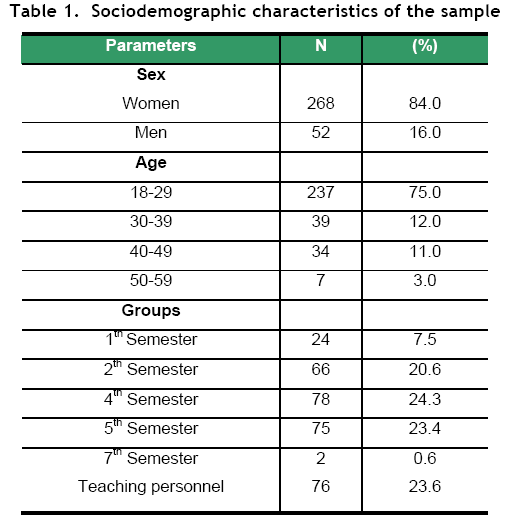
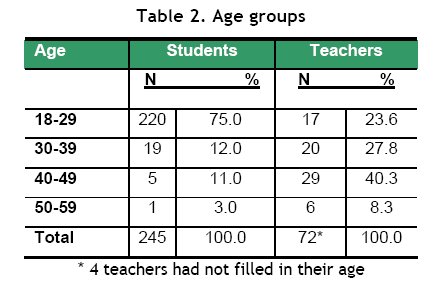
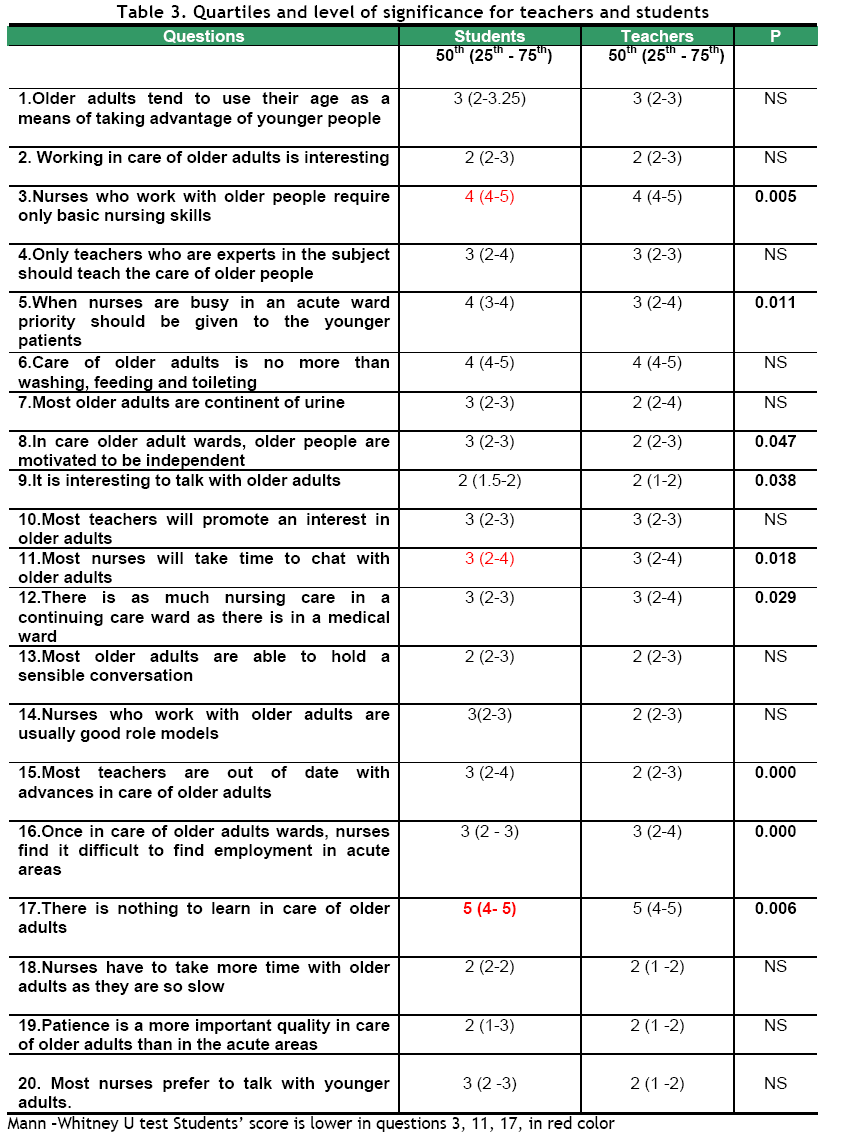
As for age groups, youngsters (either teachers or students, as no separate age comparisons groups for teachers and students were created, mainly to small or disproportionate number of individuals in some categories) gave negative answers to questions 13, 15, 18 compared to age groups 40-49, 30-39, and 40-49 respectively (Table 3). In the same way, older individuals gave negative answers to questions 2 and 9, as compared to all other age groups, while they answered positively in questions 19 and 20. All differences observed were statistically significant (Table 4).
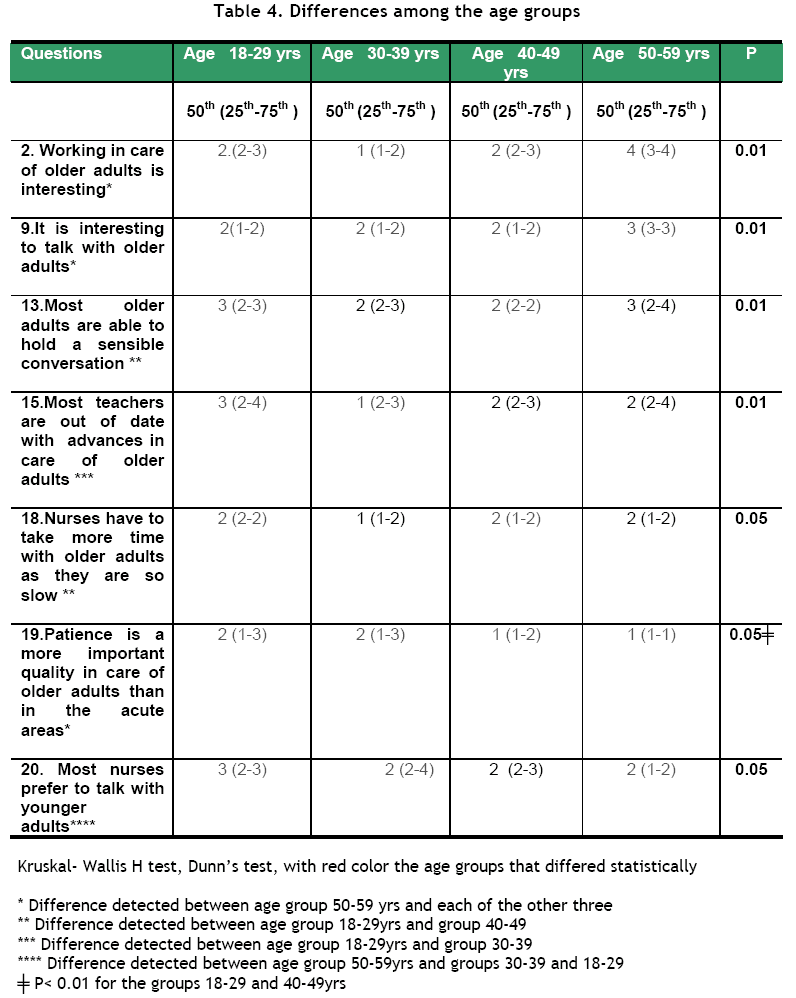
Table 5 shows the difference between genders with regard to attitudes. Women had a higher score in questions 4, 5, 17.
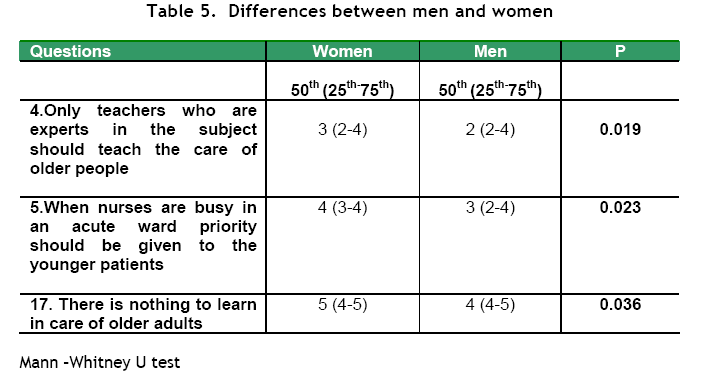
The results in Table 6 show that senior students score better than juniors. Differences between the first semester group and the other groups were a repeated finding in most questions.
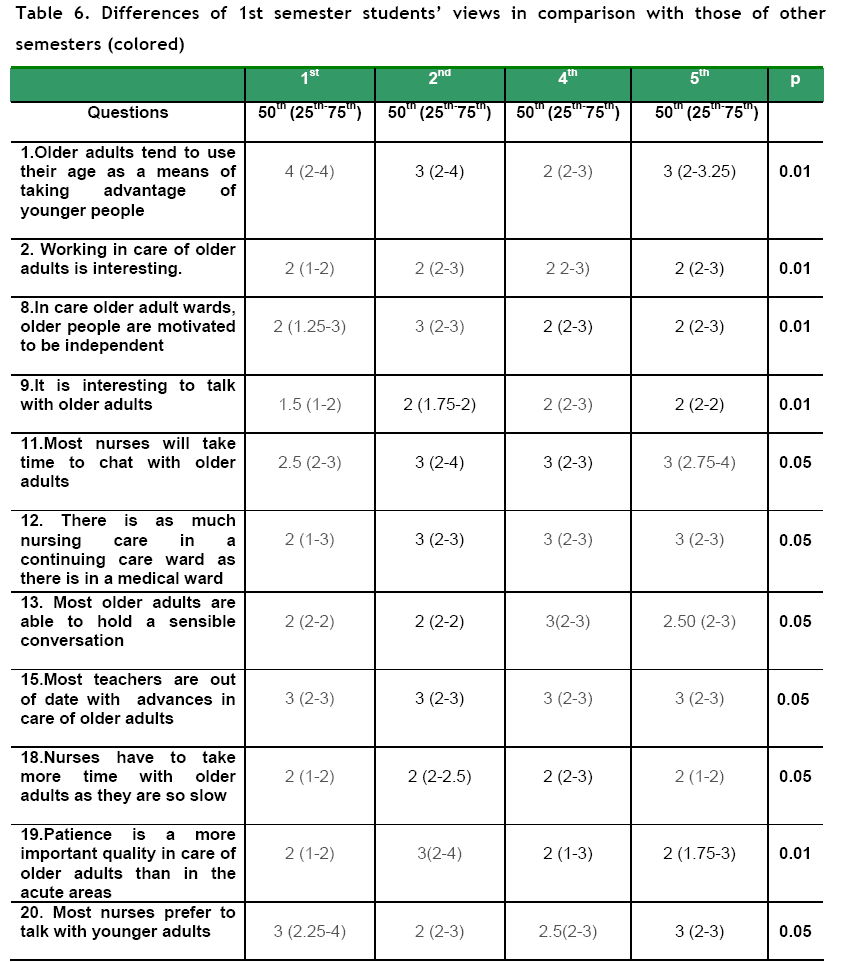
Teachers and women had in general more positive attitudes. Overall, students had a higher score, indicating a trend towards “disagree’’ answers. Differences in total score between teachers and students are presented in table 7.

Discussion
The findings of the present study revealed that nurse teachers and students had different views on several subjects. Inter- students group differences also occurred. However, an agreement in most questions was observed. It was also found that experience, age and gender were factors that finally influenced feelings towards older people in the studied groups of student nurses and nurse teachers. In general, these findings are in accordance with previous findings [11].
According to their answers in questions 3 and 6, both students and teachers recognize the complexity of caring for older people and the necessity of special knowledge in this field. Teachers scored even more convincingly. Working in the care of older adults does not seem popular; neither interesting, as mean scores reached 3. Moreover, the development of baccalaureate programs in nursing about older people had failed, due to lack of student interest [5,7]. It is observed a considerable negative attitude regarding the care of older people and misconceptions. Following a review of the relevant literature it can be remarked that nurses focus on biomedical aspects and, despite nursing rhetoric, a holistic approach is lacking. Older patients have special needs and their care could turn out to be demanding in psychological and medical terms [18-20].
Age and education seem to play a role in answers. A perception of a lack of professional perspectives in this field could explain older nurses’ negative attitude [7,17,21] Another point, noted in other studies as well, is that, in general (mean score 3), neither students, nor teachers consider older people as continent of urine. This embarrassing condition is nowadays treatable and an attempt should be made to re-educate those older adults who have incontinence [17,22]. Although students view teachers’ knowledge in caring older adults as sufficient, the age group 30-39 years old believes that teachers are rather out of date with advances in care of this age group. Deficits in nursing staff knowledge are not rare and continuous education is necessary, especially in older patients’ care [23].
When comparing age groups, it should be taken into account that almost all participants in the age group 50-59 years are teachers. Differences observed in questions 2 and 9 reflect teachers’ opinions. Teachers seem to accept that working in care of older adults is interesting and it is interesting to talk with older adults.
Teachers and males seem to agree to give priority to younger patient in contrast with students and women who disagreed with this statement. In favor of this attitude are Grant’s [24] assertion that older adults lack proper medical attention and Bullock’s [25] view that older patients who take up beds are often ignored. It should be taken into account, however, that National Health System in Greece seems to be in a continuous crisis [26]. Despite some progress in the last 25 years, there is an everlasting urgent need for beds in Greek National Health System [27] and experienced nurses often confront desperate dilemmas in this field [28].
Despite the fact that in modern western societies men are more often engaged in various tasks at home and in the family, females, no matter students, or professionals, show more positive attitudes toward older people than males. Women believe that there is a lot to learn in care of older people and that an older patient deserves the same clinical attention as a younger one. In the present study males were found somehow to favor younger over older people, as they scored lower (“strongly agree’’) in questions 4, 5 and 17. Less favourable feelings toward older people in the male sample was also found in the study of Söderhamn et al [11].
Students may believe that older patients are often confused and unable to communicate. Media and colleagues often put forward stereotypes connected to Alzheimer’s disease are put forward by media and colleagues and this fact may partially be responsible for such an attitude. It could also explain the underestimation of the patience requiring when working with older people as well as the realistic view of older nurses that most nurses do not take enough time to chat with older people [17]. This could be easy to achieve, as recent studies support that older patients are reluctant to criticize any of the hospital processes and they generally express satisfaction with their hospitalization time [29].
The 1st semester group exhibited different attitudes in many fields, implying that academic education, as well as specialization and experience along with age alter the students’ opinion of many care related issues. The first semester students, whose experience in clinical nursing was very limited, in general had more unfavorable feelings toward older people than in 4th or 5th semester students, who had almost completed their theoretical course and had some clinical experience from various specialties. These students were apt to start the clinical course, ahead of their diploma. Previous results were mixed, although there was traced that totally inexperienced nurses or students do have different attitudes in caring older people. More specific, older nurses were found to show more positive attitudes towards older people, than younger nurses or nursing students do so [11,21]. In a recent study conducted in Greece attitudes towards older people were examined which were found to be more positive in final year nursing students in comparison to first year ones. These results are in line with our findings and they support the above mentioned rationale [30,31].
Clinical nursing faces many challenges nowadays, in a constantly changing world. As the number older people grow rapidly, caring for this age group becomes a matter of top priority. Quality issues emerge and educational standards should meet new demands. Lack of knowledge and educational preparation is considered to be a major obstacle in caring worldwide. Both students and teachers should be aware of new advances and dissolve prejudice.
Limitations of the study
The research was carried out in one small area in Greece and only one School of Nursing was involved. The next stage will be to widen it out to other schools. A cross-section of students made up the sample. It may have been useful to take a longitudinal approach to the study and follow a cohort through one year of nurse education so that attitudes could be measured at different time frames. A comparison between different age groups of both teachers and students would be helpful, as teachers are likely to be found in the older age groups. As a result of some age overlapping between teachers and students differences should be interpreted cautiously as, the data for students and staff cannot be fully disaggregated.The reliability might have been improved by using larger sample sizes during the pilot work. Further pilot work will be carried out with the questionnaire to try and improve the reliability.
Conclusions
There is a considerable shift in students’ attitudes toward caring older people from the first to third year of the academic course. Despite the positive attitudes expressed in many items of the scale, students need opportunities to develop positive attitudes toward the older people and significant efforts are required to mobilize young nurses towards issues about caring of older adults, with an emphasis on a holistic approach. Even though education is associated with fewer stereotypes, contact is not. It is necessary to increase optimal contact with older clients. Teachers should work along with students to dispel stereotypes that accompany ageing and adopt their model of care to modern directives.
3583
References
- Ford P, McCormack B. Future directions for gerontology: a nursing perspective. Nurse Educ Today 2000; 20: 389-394.
- Hendrix CC, Wojciechowski CW. Chronic care management for the elderly: an opportunity for gerontological nurse practitioners. J Am Acad Nurse Pract. 2005;17(7): 263-267.
- Kennedy-Malone L, Penrod J, Kohlenberg EM, Letvak SA, Crane PB, Tesh A, Kolanowski A, Hupcey J, Milone-Nuzzo P. Integrating gerontology competencies into graduate nursing programs. J Prof Nurs. 2006; 22 (2): 123-128.
- General Secretariat of the National Statistical Service of Greece. (Online). Population projections - Assumptions (Years 2007 - 2050), Available from: https://www.statistics.gr/portal/page/portal/ESYE (Accessed March 21, 2010)
- Ryan M, McCauley D. We built it and they did not come: knowledge and attitudes of baccalaureate nursing students toward the elderly. JNY State Nurses Assoc. 2005;35(2): 5-9.
- Edwards HE, Forster EM. Quality care through residential reforms: the role of attitudes, regulation and education. Geriaction 1998;16 (3): 5?10.
- Wells Y, Foreman P, Gething L, Petralia W. Nurses' attitudes toward aging and older adults--examining attitudes and practices among health services providers in Australia. J Gerontol Nurs. 2004;30(9): 5-13
- Joy JP, Carter DE, Smith LN. The evolving educational needs of nurses caring for the older adult: a literature review. J Adv Nurs. 2000; 31:1039?1045
- Kelly TB, Tolson D, Schofield I, Booth J. Describing gerontological nursing: an academic exercise or prerequisite for progress? J Clin Nurs. 2005; 14(Suppl 1):13?23
- Happell B, Brooker J . Who will look after my grandmother? Attitudes of student nurses toward the care of older adult. J Gerontol Nurs. 2001; (December) 12?17.
- S?derhamn O, Lindencrona C, Gustafson SM. Attitudes toward older people among nursing students and registered nurses in Sweden. Nurse Educ Today 2001; 21(3): 225-229.
- Fagerberg I, Ekman SL. First-Year Swedish Nursing Students' Experiences with Elderly Patients. WJNR. 1997; 19(2): 177-189.
- Fagerberg I, Ekman SL, Ericsson K. Two studies of the new nursing education in Sweden: I. The place of gerontology and geriatrics. 2. Student characteristics and expectations. Nurse Educ Today 1997; 17(2):150-7.
- Haight BK, Christ MA, Dias JK. Does nursing education promote ageism? J Adv Nurs. 1994; 20(2):382-90.
- Chuang YH, Huang HT. Nurses' feelings and thoughts about using physical restraints on hospitalized older patients. J Clin Nurs. 2007; 16 (3): 486-494
- Courtney M, Tong S, Walsh A. Acute-care nurses' attitudes towards older patients: a literature review. Int J Nurs Pract. 2000; 6 (2): 62-69.
- McLafferty EA. Comparison of nurse teachers' and student nurses' attitudes toward hospitalised older adults. Nurse Educ Today 2005; 25(6): 472-479.
- Choowattanapakorn T, Nay R, Fetherstonhaugh D. Nursing older people in Thailand: Embryonic holistic rhetoric and the biomedical reality of practice. Geriatr Nurs. 2004; 25 (1):17-23
- Mellor P, Chew D, Greenhill J. Nurses? attitudes toward elderly people and knowledge of gerontic care in a multi-purpose health service (MPHS). Aust J Adv Nurs. 2007; 24(4): 37-41
- Reyna C, Goodwin EJ, Ferrari JR. Older adult stereotypes among care providers in residential care facilities: examining the relationship between contact, education, and ageism. J Gerontol Nurs. 2007; 33(2): 50-55.
- Hweidi IM, Al-Obeisat SM. Jordanian nursing students' attitudes toward the elderly. Nurse Educ Today 2006; 26(1): 23-30
- Roe B, Doll H. Prevalence of urinary incontinence and its relationship with health status. J Clin Nurs. 2000; 9(2): 178-187.
- Zwakhalen SM, Hamers JP, Peijnenburg RH, Berger MP. Nursing staff knowledge and beliefs about pain in elderly nursing home residents with dementia. Pain Res Manag. 2007; 12(3): 177-184.
- Grant LD. Effects of ageism on individual and health care providers? responses to healthy aging. Health Social Workers. 1996; 21: 9-15
- Bullock R. Elderly care. Armchair theatre. Health Serv J. 2000; 110 (5707): 22-23.
- Kihlgren AL, Nilsson M, S?rlie V. Caring for older patients at an emergency department -- emergency nurses' reasoning. J Clin Nurs. 2005; 14(5): 601-608.
- Tountas Y, Karnaki P, Pavi E. Reforming the reform: the Greek National Health System in transition. Health Policy 2002; 62(1):15 -29.
- Petmesidou M, Mosialos E. Social policy developments in Greece. London: Ashgate, 2006.
- Stefanis CN, Madianos MG. Mental health care delivery system in Greece: a critical overview. Bibl Psychiatr. 1981; 160: 78-83.
- Richardson S, Casey M, Hider P. Following the patient journey: Older persons' experiences of emergency departments and discharge. Accid Emerg Nurs. 2007; 15(3):134-140 .
- Lambrinou E, Sourtzi P, Kalokerinou A, Lemonidou C. Attitudes and knowledge of the Greek nursing students towards older people. Nurse Educ Today 2009;29(6): 617-622












